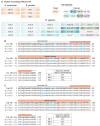Exploring the Molecular Underpinnings of Cancer-Causing Oncohistone Mutants Using Yeast as a Model
- PMID: 38132788
- PMCID: PMC10744705
- DOI: 10.3390/jof9121187
Exploring the Molecular Underpinnings of Cancer-Causing Oncohistone Mutants Using Yeast as a Model
Abstract
Understanding the molecular basis of cancer initiation and progression is critical in developing effective treatment strategies. Recently, mutations in genes encoding histone proteins that drive oncogenesis have been identified, converting these essential proteins into "oncohistones". Understanding how oncohistone mutants, which are commonly single missense mutations, subvert the normal function of histones to drive oncogenesis requires defining the functional consequences of such changes. Histones genes are present in multiple copies in the human genome with 15 genes encoding histone H3 isoforms, the histone for which the majority of oncohistone variants have been analyzed thus far. With so many wildtype histone proteins being expressed simultaneously within the oncohistone, it can be difficult to decipher the precise mechanistic consequences of the mutant protein. In contrast to humans, budding and fission yeast contain only two or three histone H3 genes, respectively. Furthermore, yeast histones share ~90% sequence identity with human H3 protein. Its genetic simplicity and evolutionary conservation make yeast an excellent model for characterizing oncohistones. The power of genetic approaches can also be exploited in yeast models to define cellular signaling pathways that could serve as actionable therapeutic targets. In this review, we focus on the value of yeast models to serve as a discovery tool that can provide mechanistic insights and inform subsequent translational studies in humans.
Keywords: budding yeast; cancer; epigenetics; fission yeast; histone; oncohistone.
Conflict of interest statement
The authors declare no conflict of interest.
Figures




References
-
- Xu J., Murphy S.L., Kochanek K.D., Arias E. Mortality in the United States. National Center for Health Statistics; Hyattsville, MD, USA: 2022. pp. 1–8. 2021 NCHS Data Brief.
Publication types
Grants and funding
LinkOut - more resources
Full Text Sources

